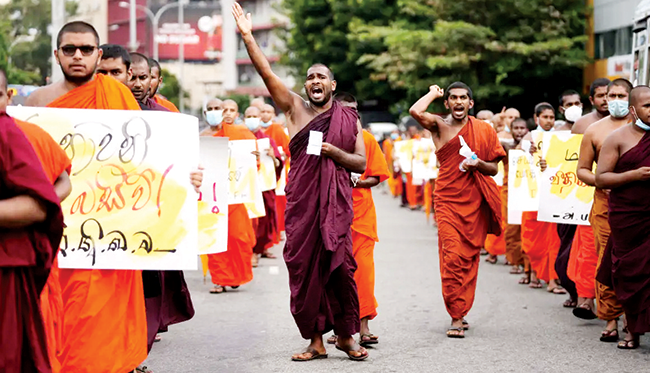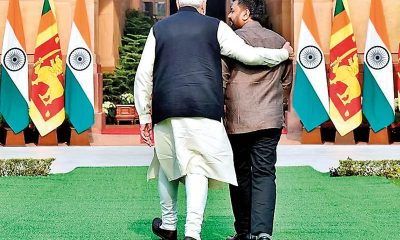Opinion
What is the essence of human life?

One political analyst cum social activist recently condemned Sri Lankan Buddhist monks on his YouTube channel for not raising enough voice against the massive destruction taking place in the country. According to him, the main element of the current crisis is some foreign powers striving to unsettle the country for their geo-political needs. Many other Buddhists ask fervently: “Why are monks silent?”
The right-thinking Buddhists do not expect monks to take part in the struggle in a gross way that causes further deterioration of societal virtues. Some antagonists infiltrate hired goons dressed in yellow robes into violent protests, aimed at causing disgrace to Buddhist monks. Therefore, this question is actually about virtuous monks who are conscious of what they are doing. But why do they seem to be inactive?
Buddha demonstrated that everything happens due to multiple of reasons, and there are no sole-factor operations in the universe. It is a significant fact that comes in the teaching of Buddhist doctrine. Many analysts and their ilk, when tracing down to the roots of the problems, often fail to take some pertinent facts into consideration. The norm of Karma and Norm of Mind are two basic laws that govern this universe. I have observed that many laymen often conveniently forget the karmic aspect of this phenomenon.
The Buddha in many discourses like Aggañña sutta, Cakkawatti Sihanada sutta, etc., disclosed that, with the deterioration of virtue, human lives would become increasingly miserable, and even Mother Nature would be hostile towards them at such a stage. Virtue is getting increasingly neglected in our society. Electronic media takes the forefront in fanning the flames of delusion unrestrained for aggravating the situation, whatever it may be. They are concerned only about the popularity of their particular channel or stream, heedless of the grave damage they do in doing so. Heedlessness (pamaada) has become the norm of the current society. Even when slaughtering of animals is considered, the accrued evil karma would be massive, and it is only a matter of time before they come into fruition. One can earn a wealth of experience by careful observation of what unfolds around at present. First, the sweep of the pandemic claimed many lives. Subsequently, those who survived it had to deal with the new challenges that stemmed from the economic downfall that came in its wake. A global food crisis is in the offing, and the possibility of a third world war also cannot be ruled out. All these disasters prey on human lives!
The effects of evil karma can be eliminated to some extent by setting our mind on the spiritual path. This is known as tactfulness (payogasampatti) and it comes under the domain of the Norm of Mind. The right-thinking monks raised alarm long before these crises (See my article published in this newspaper titled “A lockdown like no other” on May 27, 2020). They emphasised the significance of spiritual tactfulness in mitigating them but many paid no heed. Some even went to the extent of ridiculing such monks of fear-mongering! Most of the people wanted to keep up with their fantasies. A saying of a scholar explains this situation: “So many people walk around with a meaningless life. They seem half-asleep, even when they’re busy doing things they think are important. This is because they’re chasing the wrong things.”
According to the Awakened One, there indeed is a gratification (assaada) in the world. That is why people get infatuated with it. Then again, there is a danger (aadinawa) with regard to the world; that is why people become disappointed in this world. Not only gratification and danger, but there is also an escape (nissarana) from this world. That is how people get liberated and realize taking refuge in Nibbana. In an ultimate sense, there is no lasting permanent entity called a ‘person’ but just an empty phenomenon rolls on in a ’cause-and-effect’ relationship, creating the false impression of a ‘person’. This trio of ‘gratification’, ‘danger’ and ‘escape’ carry out their ‘legendary’ duty of binding, turning away and pointing towards the escape, respectively. In other words, if people do not see the futility and the pervasive unsatisfactoriness of the world, repeatedly, in many ways, they will never have true maturity in life. That is the bitter truth about the world! Unfortunately, there is no way to skip some steps of this learning process but erudite monks can help, only if you pay attention. Having seen this universal phenomenon, how come real monks impress you at this juncture like the heroes of the worthless films?
Corruption, cronyism, racism, etc., are actually outward manifestations of inner conflicts—i.e., defiled mental states. A real change should come from within, not without. Those who seek instant relief, quick satisfaction and fast fixes find it difficult to understand what is embodied in this Dhamma. As Ven. Achaan Cha of universal fame has so vividly stated, people behave like (obscenely) greedy men who gobble down a large amount of (unhealthy) food, not knowing where the toilet is! Should monks be held responsible for the discomfort?
As monks, our model of social activism should be based on a different life philosophy called Right View and our endeavours should fall into the category of ‘Right Effort’. On the contrary, the majority of people have embraced Wrong Views and get entangled with Wrong Concepts, Wrong Actions, Wrong Livelihood etc. that entail it. Whether the culprit of the current crisis is a foreign intervention or not we have to set ourselves on the Right View to overcome, or at least to mitigate, the ill effects. If people are not ready to change their perspective and gain the much-needed sanity, popularizing the hypothesis of a foreign intervention by using media platforms only makes matters worse by adding fuel to the raging wrath. We were born into this world because of our previous ills – unfavorable karma, and if we keep on accruing more bad karma in our struggle of life, the vicious cycle would continue. “Whence are we going to close the bank account of our existence? Therefore, patience is of utmost importance to put an end to suffering”, said Buddha. In fact, Buddha admonished that the truth also should be uttered with restrain—otherwise we might do more harm than good (Chodana sutta– AN).
Way back in the 1950s, the legendary Buddhist scholar Venerable Rérukané Chandawimala Thero wrote that many people are jealous of monks, probably for getting certain benefits and respect from the faithful Buddhists. So, they criticise monks to their hearts’ content, not knowing the underlying thrust of negative emotions that dictate their behaviour! However, in a closer inspection, you will see that everybody is fighting a hard battle, and the monks are not exempted! Such mindful, non-judgmental observations give rise to compassion. If we are truly human, all our actions should spring from compassion—and it leads to constructive criticism and not to a blame-game widespread in the contemporary world.
You are not alone in your struggle of life—aspiring Buddhas, virtuous monks and compassionate gods too are with you, doing their best to lessen your suffering. However, the situation cries for an attitudinal and behavioural change on your part. Those who try to fulfill this requirement will at least leave this life somewhat wiser than they found it at their birth. Even before the onset of these catastrophes, the death rate was actually 100%. We were born to die, but many people forget it, which is another conducive factor for many morally destructive behaviors. Then, how can we make sense of this problem-ridden life? Learning to live a life of meaning, and helping fellow beings also to find progressively deeper meaning, is the essence of human life.We honor and appreciate the efforts of social activists who endeavor to protect our motherland. While doing it, one should not forget that he/she too needs to upgrade his/her own perspectives accordingly.
Ven. Matthumagala Chandananda Thero
Sri Vinayalankararamaya
Pokunuwita
Opinion
Boxing day tsunami:Unforgettable experience

The first and only tsunami that Sri Lanka experienced was on Boxing Day(26th) of December 2004. My wife and I, as usual, went down to Modara in Moratuwa to purchase our seafood requirements of seafood from our familiar fishmonger, Siltin, from whom we had been buying fish for a long time. Sometimes we used to take a couple of friends of ours. But on this day, it was only both of us that went on this trip.
We made our purchases and were returning home and when we came up to the Dehiwala bridge, many people were looking down at the canal from both sides of the bridge. This was strange, as normally if there was something unusual, it would be on one side.
Anyway, we came home unaware of anything that had happened. A school friend of mine (sadly he is no longer with us) telephoned me and asked whether I was aware of what had happened. When I answered him in the negative, he told me to switch on the TV and watch. Then when I did so and saw what was happening, I was shocked. But still I did not know that we had just managed to escape being swept away by the tsunami.
Later, when I telephoned Siltin and asked him, he said that both of us had a narrow escape. Soon after we had left in our car, the tsunami had invaded the shore with a terrifying wave and taken away everything of the fishmongers, including their stalls, the fish, weighing scales and money. The fishmongers had managed to run to safety.
This had been about five minutes after we had left. So, it was a narrow shave to have escaped the wrath of the demining tsunami( the name many Sri Lankans came to know after it hit our island very badly}
HM NISSANKA WARAKAULLE
Opinion
Shocking jumbo deaths

Sri Lanka has recorded a staggering 375 elephant deaths in the past eleven and a half months due to a multitude of causes, according to the Department of Wildlife Conservation. U. L Thaufeeq, Deputy Director – Elephant Conservation said the deaths include 74 from gunshots, 53 from electrocution, 49 from hakka patas (explosive devices hidden in food), seven from poisoning, 10 from train accidents, three from a road accident, and six by drowning. It makes such diabolical reading!
“The causes of other deaths are due to natural causes or causes that could not be identified. Most of the elephants that died were young,” the official said.
Meanwhile, the human-elephant conflict has also taken a toll on people, with 149 human deaths reported this year.
Accordingly, human-elephant conflict has resulted in 524 deaths of both elephants and humans in 2024.
In 2023, a total of 488 elephants and 184 people have died consequent to the conflict, according to Wildlife Department statistics.
The human-elephant conflict in Sri Lanka has escalated to unprecedented levels with reasons like habitat destruction, encroachment, and the lack of sustainable coexistence measures contributing to the issue.
This is an indictment of the Wildlife Department for just giving the sad yearly statistics of shocking losses of our National treasures !
Given the fact that Sri Lanka boasts of 29.9% of the country declared as protected forests, Sri Lanka is a haven for nature lovers. Boasting 26 national parks, 10 nature reserves including 3 strict nature reserves, and 61 sanctuaries, the national parks in Sri Lanka offer an incredible variety of wildlife experiences.
Taken in that context, the million dollar question is why on earth the Wildlife Department is not being proactive to capture these magnificent animals and transport them into protected sanctuaries, thus effectively minimising dangers to villagers ?
Being a Buddhist country primarily, to turn a blind eye to these avoidable tragic deaths to mankind and wild elephants, we should be ashamed !
As a practising Buddhist myself, I think our clergy could play a major part in calling upon the Wildlife Department to get their act together sooner rather than later to protect human elephant conflicts !
Sri Lanka being a favourite destination amongst foreign tourists, they are bound to take a dim view of what is happening on the ground!
If the top brass in the responsible department are not doing their job properly, may be there is a case for the new President to intervene before it gets worse!
All animal lovers hope and pray the New Year will usher in a well coordinated plan of action put in place to ensure the well being of wildlife and villagers !
Sunil Dharmabandhu
Wales, UK
Opinion
Laws and regulations pertaining to civil aviation in SL, CAASL

This has reference to the article from the Aircraft Owners and Operators Sri Lanka, titled ‘Closer look at regulatory oversight and its impact on Tourism’, published on Tuesday, 24th December 2024.To explain further, in the beginning there was the Air Navigation Act No 15 of 1950 which was followed by the Air Navigation Regulations (ANR) of 1955. This was long before the national airline had acquired pressurised aircraft, intercontinental jets, sophisticated navigation equipment, satellite communication and automatic landing systems, and ‘glass’ flight-deck instrumentation.
Today, civil aviation in Sri Lanka is governed by Civil Aviation Act Number 14 of 2010. Yet the Air Navigation Regulations (ANR) promulgated back in 1955 remain in force.
These outdated regulations still stipulate rules forbidding the carriage of passengers on the airplane’s wings or undercarriage (landing gear). In short, they are neither practical nor user-friendly. In contrast, the Air Navigation Regulations of other countries have progressed and are easy to read, understand, and implement.
To overcome the problem of outdated regulations, as an interim measure in 1969 the then Minister of Communications and Transport, Mr E.L.B. Hurulle issued a Government Gazette notification declaring that the Standard and Recommended Procedures (SARPs) in Annexes to the ICAO Convention signed by Ceylon in 1944 shall be made law.
Even so, nothing much was done to move with the times until updating of the Civil Aviation Act 14 of 2010, while the Air Navigation Regulations remained unchanged since 1955. However, these regulations were modified from time to time by the promulgation of Implementing Standards (IS) and General Directives (GDs) which were blindly ‘cut and pasted’ by the Civil Aviation Authority of Sri Lanka (CAASL), from the ICAO (International Civil Aviation Organisation) Annexe ‘SARPS’ without much thought given. To date there are literally 99 IS’s starting from 2010.
The currently effective air navigation regulations are not in one document like the rest of the world, but all over the place and difficult for the flying public to follow as they are not regularly updated. This sad situation seems to have been noticed by the current regime.
The National Tourism Policy of the ruling NPP states, “Domestic air operations are currently limited due to high cost and regulatory restrictions. The current regulatory and operational environment will be reviewed to ensure domestic air connectivity to major tourist destinations. The potential of operating a domestic air schedule with multiple operators is proposed. Additionally, domestic airports and water aerodromes in potential key areas will be further developed, for high-end tourism growth.”
“The tourism policy recognises Sri Lanka’s potential to develop Sri Lanka’s aviation-based specialised tourism products, including fun flying, hot air ballooning, paragliding, parachuting and skydiving, and scenic seaplane operations. To facilitate the growth of these niche markets, existing regulations will be reviewed with the aim of attracting capable investors to develop and operate these offerings.”
It remains to be seen whether the NPP government lives up to those promises.
Note:
That OPA report talks of two funds: ‘Connectivity’ and ‘Viability’ for a limited period like three or five years to help jump-start the domestic aviation industry.
The ‘Connectivity Fund’ will cap the seat price for local passengers to a more affordable value to destinations while the ‘Viability Fund’ will assume that all seats are occupied and compensate the operator for any unutilised seat. The intention is to popularise domestic aviation as a safe, quick and convenient mode of transport.
Capt. Gihan A Fernando
RCyAF/ SLAF, Air Ceylon, Air Lanka, Singapore Airlines and Sri Lankan Airlines.
Now A Fun Flier
-

 Sports5 days ago
Sports5 days agoPathirana set to sling his way into Kiwi hearts
-

 News3 days ago
News3 days agoOffice of CDS likely to be scrapped; top defence changes on the cards
-

 News6 days ago
News6 days agoSL issues USD 10.4 bn macro-linked bonds
-

 Editorial6 days ago
Editorial6 days agoRanil’s advice
-

 Editorial5 days ago
Editorial5 days agoThe games they play
-

 Features3 days ago
Features3 days agoAn Absurd play in Parliament: Qualifications versus education
-

 Opinion4 days ago
Opinion4 days agoWhat AKD and NPP should bear in mind
-

 Features5 days ago
Features5 days agoThe Government’s Term Tests & Results: The Good, the Bad and the Ugly











